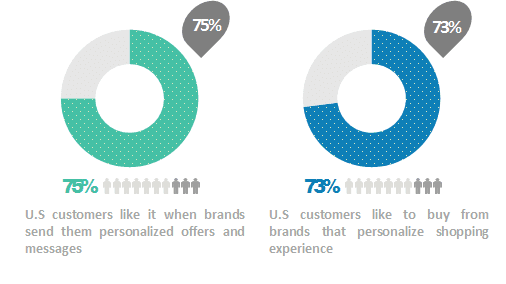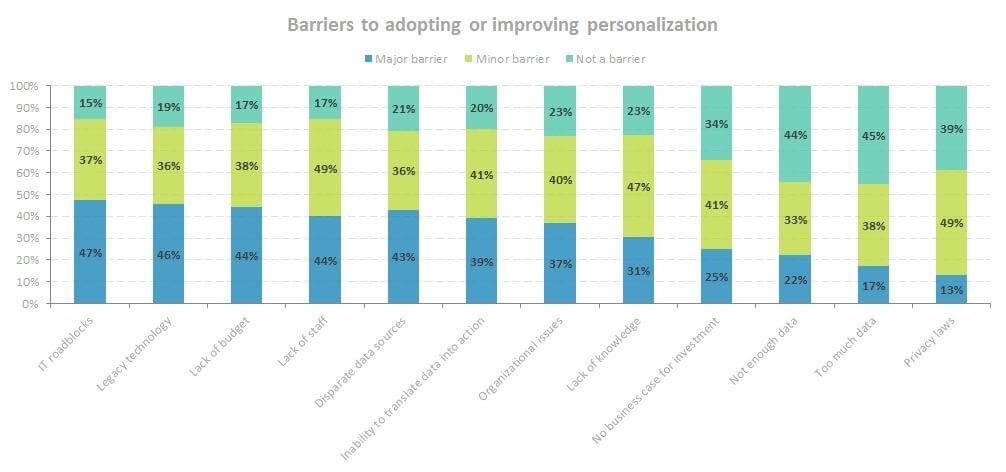5 Steps to Personalize Your Marketing Communication for Better Conversions
Imagine you go to a coffee shop early in the morning, running late for work and being drowsy after scarcely slept night. You enter and a barista welcomes you with warm greeting asking if you want your favorite vanilla latte with nonfat milk. Similar situation on another day in a different coffee place. You walk in to a crowded room, wait in a line, order a hot drink and leave unrecognized. Which situation would be more desired for you? Probably, the first one. The simplest reason for that is the fact that people love feeling special and being noticed.
Therefore, companies pay much more attention to personalization of their products and services. According to Monetate.com, 94% of companies believe that personalization is critical to current and future success. However, there is still a significant gap between how it is supposed to be and how it actually looks like. More than a half of companies still lack personalized websites experience for visitors.
There is the field left clear for marketers who know how to seize the opportunity and stand out with individual approach to each and every client. What is more, digital technology available on the market enables to personalize your services even for a mass customer. You just need to remember about few things.
The World of Data
We no longer live in the world in which people feel that are stalked when brands know details about their preferences and interests. 75% of U.S. customers are satisfied when they get personalized gifts and offers (only 6% disagree with that), even if it is related to providing personal information and with less privacy. Accordingly, nearly three quarters (73%) of consumers prefer buying from companies and producers that adjust offer to customers’ individual needs. Moreover, most of customers believe that sharing information helps them get more attractive discounts and offers matching to their preferences.

Personalization Pays Off
Companies that have introduced personalization to a greater or lesser extent see huge difference in conversion rates, engagement and performance results. For instance, personalizing just an e-mail subject line increases unique open rates by 26% on average (source: https://martech.org/study-70-brands-personalizing-emails-missing-higher-transaction-rates-revenue/).
What is more, personalized website experience affects improvement in sales results. Especially, when this experience is adopted across different devices. Two third customers use multiple devices during buying cycle and almost 30% strongly value a quality mobile experience (MyBuys). Therefore, you should seriously consider your web design on all devices. People are willing to spend more money in retail stores, which provide individual offer, adjusted to customer’s preferences, even though it diminish their sense of privacy.
Awareness vs. Reality
Although, the vast majority of companies and marketers notice the importance of personalization in marketing communication (96%, Monetate), still only 6% of the surveyed have strong personalization strategy and over a half of business do not use CRM data for personalization.
Main reasons for that is poor knowledge about the possibilities of personalization – companies simply don’t know how to do it. Major barriers in implementing it are technology-related. Specialists encounter difficulties in translating data into action. Obstacle concern also lack of resources, both in terms of staff and budget.

It Is Not a Rocket Science
75% of consumers get annoyed when offered content is not matched to their interests. The most common reasons for U.S. email users to unsubscribe from an email subscription are too many emails (69%) and content that is no longer relevant (56%). Thus it is worth investing some effort and time into preparation of a proper personalization strategy. Here are the 5 keys for your success:
- Collect all the important data – People leave loads of information about themselves in distinct places, both online and offline. Don’t miss anything that might be crucial for your operation. Invest in marketing automation tools that will help you with this task. Track what people say about your brand online and how they behave on your site. Collect wide range of demographic data. It is all there for you, you just need to learn how to leverage it.
- Review and analyse your data frequently – Something that is true today, might be out of date tomorrow and you do not want to base your activity on false information. Your target group changes constantly and you should follow their needs and expectations all the time.
- Personalize your marketing communication in all aspects – One of the most pleasant words that a person can hear is his or her own name. So use it whether you write to your existing client or a prospect. Use it in email subject line and starting your message. It also applies to social media communication. On top of that, there are plenty of tools like Intrecom.io or GetResponse that provide a wide array of functionalities that make your communication even more personalized. Essentially, remember that customers prefer talking to people rather than automated machines, so make your messages sound as personal as possible. Clients will appreciate your effort.
- Develop a feedback system – Your brand is an entirety of all the experiences that your customer associate with a defined product or service. Their opinion and feedback should be the most important factor when developing and upgrading it. Make sure, you leave a lot of space for expressing clients opinions and advice.
- Provide quality website experience across all devices – Average user owns 2.9 mobile devices and uses them alternately. Very often clients are discouraged by poor web design even if it concerns only a mobile version. Thus make sure your site is user-friendly across all devices.
6% marketers have fixed personalization strategy. Are you one of them? Leave us a comment!
Top Reads
Brand Monitoring: Tools & Guide for 2026
Brand Awareness Strategy [The Ultimate Guide for 2026]
The Best AI Hashtag Tracker and Other Hashtag Tracking Tools [2026]
Social Media Reach: How to Measure & Improve It in 2026?
X (Twitter) Analytics Tools: The 10 Best to Try in 2026
Sentiment Analysis: What is it & Why do You Need it in 2026?
Share of Voice: Definition, Calculation, Tools [2026 Guide]
Brand Reputation Management: 6 Expert Tips for 2026
A Complete Guide to AI Social Media Analysis [2025]
How to See How Many Times a Hashtag Was Used on X (Twitter)
Start Social Listening!
Get the Brand24 trial and start social listening like a PRO.